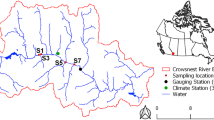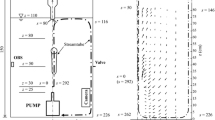Abstract
Multimodal particle size distributions (PSDs) of fine-grained cohesive sediments are common in marine and coastal environments. The curve-fitting software in this study decomposed such multimodal PSDs into subordinate log-normal PSDs. Four modal peaks, consisting of four-level ordered structures of primary particles, flocculi, microflocs, and macroflocs, were identified and found to alternately rise and sink in a flow-varying tidal cycle due to shear-dependent flocculation. The four modal PSD could be simplified further into two discrete size groups of flocculi and flocs. This allowed the development of a two-class population balance equation (TCPBE) model with flocculi and flocs to simulate flocculation involving multimodal PSDs. The one-dimensional vertical (1-DV) TCPBE model further incorporated the Navier-Stokes equation with the k-ε turbulence closure and the sediment mass balance equations. Multimodal flocculation as well as turbulent flow and sediment transport in a flow-varying tidal cycle could be simulated well using the proposed model. The 1-DV TCPBE was concluded to be the simplest model that is capable of simulating multimodal flocculation in the turbulent flow field of marine and coastal zones.





Similar content being viewed by others
References
Agrawal Y, Pottsmith H (2000) Instruments for particle size and settling velocity observations in sediment transport. Mar Geol 168:89–114
Andrews S, Nover D, Schladow S (2010) Using laser diffraction data to obtain accurate particle size distributions: the role of particle composition. Limnol Oceanogr Methods 8:507–526
Ariathurai, C. (1974), A finite element model for sediment transport in estuaries, PhD Dissertation, University of California, Davis
Aro C, Rodrigue G, Rotman D (1999) A high performance chemical kinetics algorithm for 3-D atmospheric models. Int J High Perform Comput Appl 13(1):3–15
Baeye M, Fettweis M, Voulgaris G, Van Lancker V (2011) Sediment mobility in response to tidal and wind-driven flows along the Belgian inner shelf, southern North Sea. Ocean Dyn 61(5):611–622
Burchard H, Baumert H (1998) The formation of estuarine turbidity maxima due to density effects in the salt wedge. A hydrodynamic process study. J Phys Oceanogr 28:309–321
Burd A, Jackson G (2002) Modeling steady-state particle size spectra. Environ Sci Technol 36:323–327
Conley D, Falchetti S, Lohmann I, Brocchini M (2008) The effects of flow stratification by non-cohesive sediment on transport in high-energy wave-driven flows. J Fluid Mech 610:43–67
Eisma D (1986) Flocculation and de-flocculation of suspended matter in estuaries. Neth J Sea Res 20:183–199
Fettweis M (2008) Uncertainty of excess density and settling velocity of mud flocs derived from in situ measurements. Estuar Coast Shelf Sci 78(2):426–436
Fettweis M, Francken F, Pison V, Van den Eynde D (2006) Suspended particulate matter dynamics and aggregate sizes in a high turbidity area. Mar Geol 235:63–74
Fettweis M, Francken F, Van den Eynde D, Verwaest T, Janssens J, Van Lancker V (2010) Storm influence on SPM concentrations in a coastal turbidity maximum area with high anthropogenic impact (southern North Sea). Cont Shelf Res 30:1417–1427
Fettweis M, Baeye M, Lee B, Chen P, Yu J (2012) Hydro-meteological influences and multimodal suspended particle size distribution in the Belgian nearshore area (southern North Sea). Geo-Mar Lett 32(2):123–137
Firth B, Hunter R (1976) Flow properties of coagulated colloidal suspensions. J Colloid Interface Sci 57:248–275
Francois R (1985) Studie van de uitvlokking van kaolinietsuspensies met behulp van aluminiumsulfaat. PhD Thesis, University of Leuven, Belgium (in Dutch)
Gibbs R (1985) Estuarine flocs: Their size, settling velocity and density. J Geophys Res 90(c2):3249–3251
Hinds W (1999) Aerosol technology: properties, behavior, and measurement of airborne particles, 2nd edn. Wiley, New York, NY
Huerta A, Liu W (1988) Viscous flow with large free surface motion. Comput Methods Appl Mech Eng 69:277–324
Krone R (1962) Flume studies of the transport of sediment in estuarial shoaling processes. Technical Report, Hydraulic Engineering Laboratory, University of California, Berkeley California, USA
Le Hir P, Cayocca F, Waeles B (2011) Dynamics of sand and mud mixtures: a multiprocess-based modelling strategy. Cont Shelf Res. doi:10.1016/j.csr.2010.12.009
Lee B, Toorman E, Molz F, Wang J (2011) A two-class population balance equation yielding bimodal flocculation of marine or estuarine sediments. Water Res 45(5):2131–2145
Lee B, Fettweis M, Toorman E, Molz F (2012) Multimodality of a particle size distribution of cohesive suspended particulate matters in a coastal zone. J Geophys Res - Ocean 117, C03014. doi:10.1029/2011JC007552
Letter J, Mehta A (2011) A heuristic examination of cohesive sediment bed exchange in turbulent flows. Coast Eng 58(8):779–789
Luyten P, Carniel S, Umgiesser G (2002) Validation of turbulence closure parameterisations for stably stratified flows using the PROVESS turbulence measurements in the North Sea. J Sea Res 47:239–267
Maerz J, Wirtz K (2009) Resolving physically and biologically driven suspended particulate matter dynamics in a tidal basin with a distribution-based model. Estuar Coast Shelf Sci 84:128–138
Maggi F (2009) Biological flocculation of suspended particles in nutrient-rich aqueous ecosystems. J Hydrol 376:116–125
Manning A, Bass S, Dyer K (2006) Floc properties in the turbidity maximum of a mesotidal estuary during neap and spring tidal conditions. Mar Geol 235:193–211
Michaels A, Bolger J (1962) Settling rates and sediment volumes of flocculated kaoline suspensions. Indian Eng Chem Fund 1:24–33
Munk W, Anderson E (1948) Notes on a theory of the thermocline. J Mar Res 3(1):276–295
Richardson J, Zaki W (1954) Sedimentation and fluidisation, part I. Trans Inst Chem Engrs 2:35–53
Rodi W (1980) Turbulence models and their application in hydraulics, IAHR State-of-the-Art Paper
Schiller L (1932) Fallversuche mit kugeln und scheiben in Handbuch der experimental-Physik, IV., Akademische Verlagsgesellschaft Leipzig
Sherwood C, Lacy J, Voulgaris G (2006) Shear velocity estimates on the inner shelf off Grays Harbor, Washington, USA. Continental Shelf Res 26:1995–2018
Son M, Hsu T (2009) The effect of variable yield strength and variable fractal dimension on flocculation of cohesive sediment. Water Res 43:3582–3592
Toorman E (1999) Sedimentation and self-weight consolidation: constitutive equations and numerical modelling. Geotechnique 49(6):709–726
Toorman E (2003) Validation of macroscopic modelling of particle-laden turbulent flows, in Proceedings 6th Belgian National Congress on Theoretical and Applied Mechanic, Gent
Trowbridge J, Elgar S (2001) Turbulence measurements in the surf zone. J Phys Oceanogr 31:2403–2417
van Leussen W (1994) Estuarine macroflocs: their role in fine-grained sediment transport. Universiteit van Utrecht, The Netherlands
Verney R, Lafite R, Claude Brun-Cottan J, Le Hir P (2011) Behaviour of a floc population during a tidal cycle: laboratory experiments and numerical modelling. Cont Shelf Res 31(10):S64–S83
Weisstein, E. (2006), Log normal distribution, MathWorld—a Wolfram Web Resources. [online] Available from: http://mathworld.wolfram.com/LogNormalDistribution.html (Accessed 22 March 2011).
Whitby K (1978) The physical characteristics of sulfur aerosols. Atmos Environ 41:S25–S49
Winterwerp J (1998) A simple model for turbulence induced flocculation of cohesive sediment. J Hydraul Eng 36(3):309–326
Winterwerp J (2011) Fine sediment transport by tidal asymmetry in the high-concentrated Ems River: indications for a regime shift in response to channel deepening. Ocean Dyn 61(2–3):203–215
Winterwerp J, van Kesteren W (2004) Introduction to the physics of cohesive sediment in the marine environment. Elsevier B.V, Amsterdam, The Netherlands
Winterwerp J, Manning A, Martens C, de Mulder T, Vanlede J (2006) A heuristic formula for turbulence-induced flocculation of cohesive sediment. Estuar Coast Shelf Sci 68:195–207
Xu F, Wang D, Riemer N (2008) Modeling flocculation processes of fine-grained particles using a size-resolved method: comparison with published laboratory experiments. Cont Shelf Res 28:2668–2677
Acknowledgments
The authors wish to acknowledge the Flemish Science Foundation (FWO Vlaanderen) for funding the FWO project no. G.0263.08 and the Royal Belgian Institute of Natural Sciences—MUMM for funding the OMFLOC project. This study was funded partly by the Maritime Access Division of the Ministry of the Flemish Community (MOMO project). The mooring and recuperation of the tripod was carried out with the RV Belgica funded by the Belgian Science Policy. The measurements would not have been possible without the technical assistance of L. Naudts and his team (Measuring Service of RBINS-OD Nature, Oostende).
Author information
Authors and Affiliations
Corresponding author
Additional information
Responsible Editor: Han Winterwerp
This article is part of the Topical Collection on the 11th International Conference on Cohesive Sediment Transport
Rights and permissions
About this article
Cite this article
Lee, B.J., Toorman, E. & Fettweis, M. Multimodal particle size distributions of fine-grained sediments: mathematical modeling and field investigation. Ocean Dynamics 64, 429–441 (2014). https://doi.org/10.1007/s10236-014-0692-y
Received:
Accepted:
Published:
Issue Date:
DOI: https://doi.org/10.1007/s10236-014-0692-y




